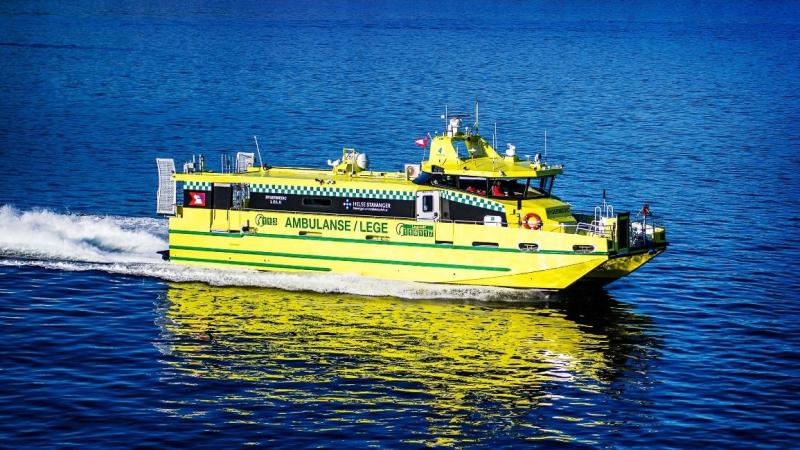Group explores ambulance vessels as part of solution to island care crisis
A working group looking into ways to bring healthcare to Maine’s island communities is considering “ambulance vessels” as a possible solution.
Rob McGraw, executive director of Atlantic Partners EMS, an agency charged with appointing representatives to the Maine EMS Board, said that a regional stakeholder group of lawmakers and community members have begun discussions about emergency boats that could take critical-condition patients to the mainland.
Martin Grimnes, president of Arcadia Alliance, which partners with international manufacturing companies to provide fast ferries for U.S. operators, said such vessels are common in his home country of Norway. They are stationed along the country’s coastline and act as mini floating hospitals.
“[Norwegians] have 60 vessels up and down the coast, doing this kind of service. And in the U.S., there’s not a single one,” Grimnes said.
Getting medical care to Maine’s islands has long been an informal arrangement for patient transport that relies heavily on the Maine Ferry Service, lobstermen, the Coast Guard, the Maine Marine Patrol, and LifeFlight.
But Grimnes has been in conversation with island authorities for a more comprehensive arrangement since 2017 — in part, he said, to preserve life on island communities.
“[The] elderly do not want to live on an island where there are uncertainties of access to medical help. Young people do not want to start a family, or God forbid, [deliver] a baby on a lobster boat,” said Grimnes, a frequent visitor to Vinalhaven.
“It would be [the Maine Department of Transportation’s] preference to get out of the patient transport business completely,” said Rick Petrie, the special projects advisor for Atlantic Partners EMS and chief operations officer for NorthEast Mobile Health Service. “We do have legislators who are willing to put in legislation to fund the operation.”
Petrie estimates the 24-hour, year-round emergency boat service to cost roughly $2.5 million in operating costs each year, plus an estimated $5 million in initial investment in the vessel.
The goal, said Petrie in a meeting in July, would be to have a funded boat transport system without relying on reimbursement. Medicare and Medicaid, the primary payers in Maine, don’t provide special reimbursement for boats.
“When you start to look at the number of calls and the reimbursement that is there we would never be able to bring in enough money for the operation of the boat.”
The group has made significant progress in the last year. The team is creating a draft to be shared with island community stakeholders for review and approval before moving forward; the group aims to establish or partner with a non-profit to be tasked with operations under the Maine Department of Transportation.
“The ferry service should be treated like any other state highway,” said Grimnes. “It is the state’s responsibility to maintain that.”
Proposal comes as rural medical care, EMS falter
The ambulance vessel proposal comes as rural care providers struggle to stay afloat. One of the state’s largest healthcare conglomerates, Northern Light, announced last week that it plans to close an internal medicine facility in Dexter, after failing to find a new location for the practice. A rural care clinic in Southwest Harbor, also owned by Northern Light, will close at the end of August.
Rural providers say they are struggling with critical staffing shortages, funding and finding housing for employees in one of the tightest housing markets in decades.
Maine’s EMS system is also widely considered to be in crisis. Last year, lawmakers approving $31 million in grants to help shore it up, although none of the money had been allocated as of January.
The problem is particularly acute on Maine’s islands. On Vinalhaven, for instance, the town has two ambulances and 14 individuals on the roster to assist in EMT calls. The three advanced EMTs, including Director Ryan Nizolek, are on call to work every weeknight and on weekends.
“We do great work, we try very hard, but a lot of us are wearing a lot of different hats on any given day,” Nizolek said. “We are having to ask more and more of volunteer time that they aren’t necessarily getting compensated for.”
In addition, the nature of transient seasonal communities offers few opportunities for licensed staff to maintain their skills.
“There are examples like that in many communities where … keeping the EMS service alive is a challenge unto itself, and much less keeping the people who work in it skilled enough,” said Dr. Katherine Simmonds, the Associate Director of Health Programs and a clinical professor at Northeastern University’s Roux Institute.
The vessels could ease the demand for other emergency transportation options, including LifeFlight.
“If we’re putting more resources on the coast, that allows LifeFlight to possibly go to some of those islands that don’t have that resource possibility,” McGraw said.
LifeFlight has seen a rise in critical transportations this summer. In the first two weeks of July, they responded to 178 calls for general emergencies, compared to less than half of that amount last year in the same period.
Maine’s only emergency air transportation service, LifeFlight, has also prepared to handle more obstetrics emergencies with the closure of maternity units throughout the state.
“We’ve been working on this for years and in anticipation, sadly, of more and more obstetrical services being abridged in the state,” said LifeFlight Executive Director Dr. Norm Dinerman.
Of LifeFlight’s 3,000 transfers last year, 191 were for pregnancy-related care.
“We’re trying to stay ahead of the curve,” Dinerman said.
Nizolek, one of the few advanced EMTs on Vinalhaven, saw firsthand the challenges women face if they are pregnant on the island. One of his friends returned to the mainland towards the end of their term to avoid pregnancy complications on the island.
“That was the better option than staying here and kind of taking a gamble about what may or may not happen,” Nizolek said. “But a large portion of our population doesn’t necessarily have that ability.”
Small islands worry they’ll be left behind
Some people who work on smaller islands have concerns about the vessel service. Donna Weigle is an EMT on Swan’s Island and also ran the island’s medical center for 16 years before retiring in 2023.
She worries that smaller, more remote destinations such as Swan’s and the Cranberry Islands would not benefit from the service if only one boat is available for all of Maine’s islands.
“In theory, it sounds really great,” Weigle said. To ensure the resources are available for all islanders, she added that “you’re going to need more than one boat.”
Weigle would support the service if it is established under a state agency supported by state or federal funding. But she wants the draft to include language that allows for expansion and for the addition of more vessels.
“I feel really good about the fact that we may be able to get this in place,” Petrie said. “This will serve all of the islands, not just the islands served by the ferry service.”
The group has discussed hosting the boat on Vinalhaven, said Nizolek, an idea the town’s Select Board is open to but cautious about, given the housing crunch on the island.
But Weigle hopes the service will ultimately live up to its intended mission.
“If I’m an EMT and I called you 10 times and I was told nine times, ‘Oh, sorry, we’re on another route’ … I think I’d be very disappointed,” Weigle said. “I think the bigger islands down in Casco Bay and down in Penobscot Bay are going to be utilizing that boat, and it’s not going to be available to us.”
































